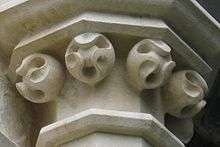Ball flower
The ball-flower (also written ballflower) is an architectural ornament in the form of a ball inserted in the cup of a flower. It came into use in the latter part of the 13th century in England and became one of the chief ornaments of the 14th century,[1] in the period known as Decorated Gothic.[2]

Ball-flower ornamentation at Gloucester Cathedral
.jpg)
Ball-flowers were generally placed in rows at equal distances in the hollow of a moulding, frequently by the sides of mullions.[1] Examples are found in many churches of the period including Gloucester Cathedral, St Mary's Church, Bloxham, St. Michael's Church, Swaton (c. 1300),[3] and Tewkesbury Abbey (c. 1330).[4] The presence of ball-flowers on the west part of Salisbury Cathedral has helped date this facade to the 14th century.[5]
References
-

- Gibbs, W. J. R. (1931). English History Notes from the Earliest Times to the League of Nations. Cambridge University Press. p. 55.
- Gardner 1922, p. 216
- Gardner 1922, p. 177
- Gleeson White (898). Bell's Cathedrals: The Cathedral Church of Salisbury (2nd ed.) – via Project Gutenberg.
Sources
- Gardner, Samuel (1922). A guide to English Gothic architecture. The University press.
This article is issued from Wikipedia. The text is licensed under Creative Commons - Attribution - Sharealike. Additional terms may apply for the media files.
